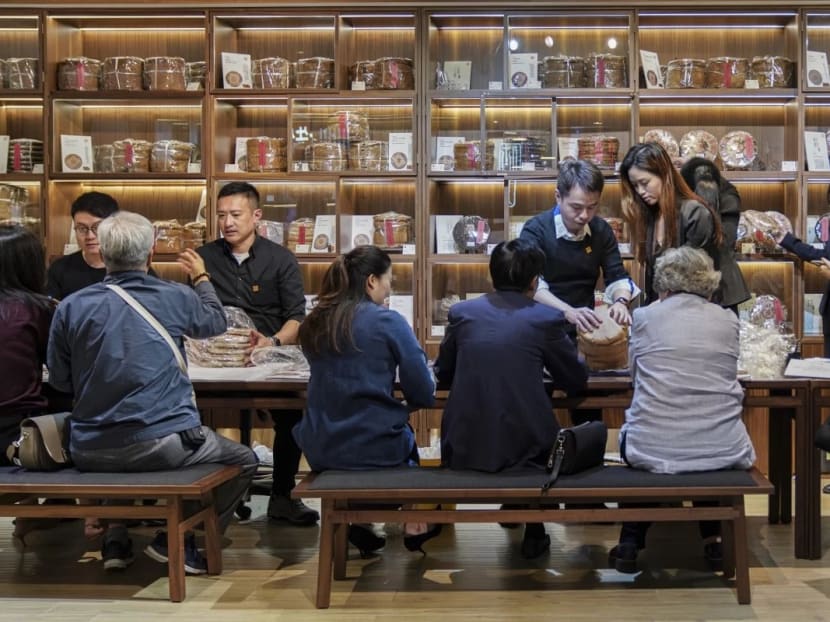Vintage Chinese teas are beating stock, commodity indices as prices soar at Hong Kong auction
HONG KONG — Vintage Chinese teas are making a mark for themselves in Hong Kong’s auction scene, with investors and collectors paying record prices, defying the gloom in a city hamstrung by months of political upheaval and a recession.

Investors and collectors gather at L&H Auction’s vintage tea exhibition and auction in November 2019.
HONG KONG — Vintage Chinese teas are making a mark for themselves in Hong Kong’s auction scene, with investors and collectors paying record prices, defying the gloom in a city hamstrung by months of political upheaval and a recession.
A stack of seven compressed cakes of Tong Xing Hao Puer tea from the 1920s went under the hammer for HK$8.4 million (S$1.46 million) before fees on Nov 24, according to auctioneer Hong Kong L&H Auction.
Local and mainland Chinese bidders drove the price to the upper end of its estimate of between HK$5.8 million and HK$8.5 million, according to Mr Zhou Zi, founder and chief executive of the Causeway Bay auction house.
That works out to be a cool 14.4 per cent compound annual growth from Mr Zhou’s estimate of HK$10,000 for its value in 1970. The appreciation is respectable compared with a 10 to 13 per cent annualised gain in Hong Kong and US benchmark stock indices over that time, or a 3.2 per cent gain from a basket of 23 commodities tracked by Bloomberg.
“Vintage Puer can be an investment vehicle because the value will keep appreciating,” Mr Zhou said in an interview. “It cannot be copied, it is a consumable product with depleting supply over time and it tastes better as it ages. These factors will keep the market on the up trend.”
The surge in prices for vintage teas has followed a recent phenomenon in modern-day collectibles and local memorabilia, with investors snapping up items like Kweichow Moutai liquor and limited-edition sneakers, as potentially the next big hits.
A series of Old Master Q comic that has defined Hong Kong’s social culture for generations, sold for five times its estimate at a Sotheby’s auction last year. The first-ever series of stamps featuring the nostalgic comic characters issued by Hongkong Post earlier this month also sold out instantly.
At the Nov 24 autumn auction, several other lots of Puer teas also fetched the upper end or went above their valuations, L&H’s Mr Zhou said. They included the red-marked Puer from the 1940s and 1950s, and the Baba Qing Puer produced in the 1980s and 1990s.
“A lot of people have money but cannot find the things they want because they did not have the means or channels to source for them,” Mr Zhou said. “In such a situation, the price will go up and set a new high over time.”
Drinking Puer on a regular basis is said to help lower blood sugar and cholesterol, reduce obesity and boost immunity.
A pastime for some ethnic minorities in China, it was not popular until it caught the attention of the imperial families in the later years of the Qing dynasty.
Mr Shan Dabao, who has been involved in tea retailing for 12 years in Beijing, said prices for vintage Puer have reached irrational levels because demand for them is not sustainable.
“Some auction houses buy and sell their own teas, driving up prices and raising their profiles,” he added. “This is the usual way to give vintage teas a sense of presence.”
Mr Shan may have a point because it was not long ago that the market for vintage teas went through its boom and bust cycle in China.
In 2017, a variety known as the King of Puer fell to 200,000 yuan (S$38,656) per kg from 6 million yuan, according to a Phoenix News report.
The famous Dayi horse zodiac tea cakes slumped 50 per cent in October 2014 from 20,600 yuan earlier in that year, Xinhua News reported.
Mr Zhou of L&H Auction said that may have been true at that time. The market profile has since changed, he added.
“One of the characteristics of those buyers is that they were retail investors and their financial strength was insufficient,” he said. “Today, investors in vintage teas are in a more solid financial position, and auction houses are able to make the market more efficient and transparent.”
To avoid falling into a speculative trap, investors should pick authentic, high-quality products and brands with liquidity, reputation and limited editions, he said. Trading at trusted and sizeable auction venues is also advisable, he added.
“We can’t control the views of vintage tea buyers or critics,” Mr Zhou said. “We just put them on the market in an open and transparent way, and let the market determine their prices.” SOUTH CHINA MORNING POST









